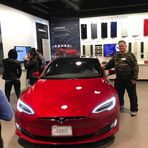Job Growth and Tesla's Decline: A Tale of Two Economies
April 3, 2025, 9:36 am

Location: United States, Nebraska, Omaha
Employees: 10001+
Founded date: 1839
Total raised: $1.9B

Location: United States, Texas, Austin
Employees: 10001+
Founded date: 2003
Total raised: $3.86B
In March 2025, the U.S. job market displayed resilience, adding 155,000 jobs. This figure surpassed expectations and marked a significant rebound from February's revised total of 84,000. The ADP report, a beacon for labor market insights, painted a picture of cautious optimism. The labor market, it seems, is not yet in retreat.
While the job numbers shine, Tesla's story tells a different tale. The electric vehicle giant reported a 13% drop in vehicle deliveries for the first quarter. This decline, coupled with a stock plunge of 36%, raises questions about the company's future.
The job growth report revealed a broad-based hiring trend. Professional and business services led the charge, adding 57,000 jobs. Financial activities followed closely, with 38,000 new positions. Manufacturing and leisure sectors contributed as well, though trade and utilities saw losses.
Wages also showed promise. Earnings rose by 4.6% year-over-year for those staying put, while job changers enjoyed a 6.5% increase. Yet, the gap between these two figures matched a series low, hinting at a stagnation in job mobility.
Despite the positive job growth, uncertainty looms. President Trump’s tariffs cast a shadow over business confidence. Companies remain wary, hesitant to expand amid shifting trade policies. The upcoming BLS report, which includes government jobs, will provide further clarity.
On the other hand, Tesla's quarterly report painted a grim picture. Deliveries fell to 336,681, down from 386,810 a year prior. Investors had anticipated higher numbers, leading to disappointment. The company's stock, once a darling of Wall Street, faced its worst quarter since 2022.
Tesla's challenges extend beyond numbers. The company faced protests and boycotts linked to CEO Elon Musk's political actions. His involvement in the Trump administration and controversial rhetoric have alienated some consumers.
Production issues also plagued Tesla. The company underwent planned shutdowns to upgrade manufacturing lines for the redesigned Model Y. While Musk remains optimistic about the Model Y's potential, competition in the EV market is fierce.
In Europe, Tesla's market share plummeted from 17.9% to 9.3%. In Germany, it fell to a mere 4%. This decline signals a growing threat from competitors like BYD.
In China, Tesla's sales dropped 11.5% year-on-year. The company faces mounting pressure from local EV makers. The once unassailable position of Tesla is now under siege.
Despite these challenges, Tesla's leadership remains confident. Musk envisions the Model Y as the best-selling car globally. However, this optimism must contend with a reality check.
The juxtaposition of job growth and Tesla's decline highlights the complexities of the current economic landscape. On one hand, the labor market shows signs of vitality. On the other, a major player in the EV sector grapples with significant setbacks.
As the economy evolves, so too must businesses. Companies must adapt to changing consumer sentiments and market dynamics. The job market may be thriving, but the path ahead is fraught with challenges.
Investors are left to ponder the implications. Will the job growth translate into sustained economic momentum? Or will Tesla's struggles signal a broader shift in the market?
The answers remain elusive. The upcoming BLS report will shed light on the labor market's trajectory. Meanwhile, Tesla must navigate its turbulent waters.
In conclusion, the U.S. economy is a tale of two narratives. Job growth offers a glimmer of hope, while Tesla's decline serves as a cautionary tale. The interplay between these forces will shape the economic landscape in the months to come.
As we move forward, vigilance is key. The job market may be robust, but the challenges facing major corporations like Tesla remind us that the road to recovery is rarely a straight line. The future remains uncertain, but one thing is clear: adaptability will be the name of the game.
While the job numbers shine, Tesla's story tells a different tale. The electric vehicle giant reported a 13% drop in vehicle deliveries for the first quarter. This decline, coupled with a stock plunge of 36%, raises questions about the company's future.
The job growth report revealed a broad-based hiring trend. Professional and business services led the charge, adding 57,000 jobs. Financial activities followed closely, with 38,000 new positions. Manufacturing and leisure sectors contributed as well, though trade and utilities saw losses.
Wages also showed promise. Earnings rose by 4.6% year-over-year for those staying put, while job changers enjoyed a 6.5% increase. Yet, the gap between these two figures matched a series low, hinting at a stagnation in job mobility.
Despite the positive job growth, uncertainty looms. President Trump’s tariffs cast a shadow over business confidence. Companies remain wary, hesitant to expand amid shifting trade policies. The upcoming BLS report, which includes government jobs, will provide further clarity.
On the other hand, Tesla's quarterly report painted a grim picture. Deliveries fell to 336,681, down from 386,810 a year prior. Investors had anticipated higher numbers, leading to disappointment. The company's stock, once a darling of Wall Street, faced its worst quarter since 2022.
Tesla's challenges extend beyond numbers. The company faced protests and boycotts linked to CEO Elon Musk's political actions. His involvement in the Trump administration and controversial rhetoric have alienated some consumers.
Production issues also plagued Tesla. The company underwent planned shutdowns to upgrade manufacturing lines for the redesigned Model Y. While Musk remains optimistic about the Model Y's potential, competition in the EV market is fierce.
In Europe, Tesla's market share plummeted from 17.9% to 9.3%. In Germany, it fell to a mere 4%. This decline signals a growing threat from competitors like BYD.
In China, Tesla's sales dropped 11.5% year-on-year. The company faces mounting pressure from local EV makers. The once unassailable position of Tesla is now under siege.
Despite these challenges, Tesla's leadership remains confident. Musk envisions the Model Y as the best-selling car globally. However, this optimism must contend with a reality check.
The juxtaposition of job growth and Tesla's decline highlights the complexities of the current economic landscape. On one hand, the labor market shows signs of vitality. On the other, a major player in the EV sector grapples with significant setbacks.
As the economy evolves, so too must businesses. Companies must adapt to changing consumer sentiments and market dynamics. The job market may be thriving, but the path ahead is fraught with challenges.
Investors are left to ponder the implications. Will the job growth translate into sustained economic momentum? Or will Tesla's struggles signal a broader shift in the market?
The answers remain elusive. The upcoming BLS report will shed light on the labor market's trajectory. Meanwhile, Tesla must navigate its turbulent waters.
In conclusion, the U.S. economy is a tale of two narratives. Job growth offers a glimmer of hope, while Tesla's decline serves as a cautionary tale. The interplay between these forces will shape the economic landscape in the months to come.
As we move forward, vigilance is key. The job market may be robust, but the challenges facing major corporations like Tesla remind us that the road to recovery is rarely a straight line. The future remains uncertain, but one thing is clear: adaptability will be the name of the game.
